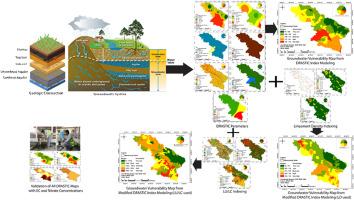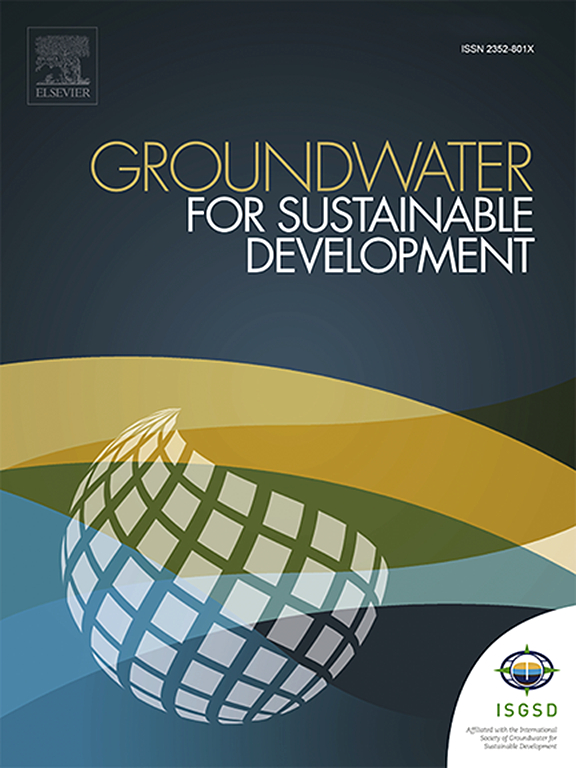Monitoring groundwater vulnerability for sustainable water resource management: A DRASTIC-based comparative assessment in a newly township area of Bangladesh
IF 4.9
Q2 ENGINEERING, ENVIRONMENTAL
引用次数: 0
Abstract
Groundwater is a vital source of freshwater in our daily lives. Global and local groundwater quality are degrading due to rapid urbanization, human interference, and policy variations, which is prominent in developing nations like Bangladesh. The major purpose of this research is to analyze aquifer vulnerability in Bangladesh's north-central area (Mymensingh) using conventional and modified DRASTIC modeling. Seven influencing hydrogeological factors were employed to develop and integrate conventional DRASTIC modeling: soil media, net recharge, aquifer depth, aquifer media, topography, hydraulic conductivity, and influence of vadose zone, while land use and lineament density were used with them for modified DRASTIC modeling. The findings from four vulnerability analysis detected 29.56% (93.35 sq.km), 22.24% (83.12 sq. km), 28.52 (106.93 sq. km), and 37.6% (140.55 sq.km) of the study area as high to very high vulnerable zones for groundwater pollution. Lower groundwater depth, higher hydraulic conductivity, moderate to high groundwater recharge, dense lineaments, dense settlement, agricultural land, and inland waterbodies together might indicate a high vulnerability in the research area. The validation results based on EC and nitrate levels show that conventional (r = 0.884, p ≤ 0.01; r = 0.951, p ≤ 0.01) and modified DRASTIC models (r = 0.868, p ≤ 0.01; r = 0.840, p ≤ 0.01) have a stronger association with unconfined aquifers, than confined aquifers. Modification with both additional parameters showed more accuracy compared to the conventional one. Frequent monitoring of groundwater quality in high and moderately vulnerable zones is recommended for earlier detection and prevention of potential aquifer degradation.

监测地下水脆弱性,促进可持续水资源管理:孟加拉国一个新城镇地区基于 DRASTIC 的比较评估
地下水是我们日常生活中的重要淡水来源。由于快速城市化、人为干扰和政策变化,全球和当地的地下水质量正在恶化,这在孟加拉国等发展中国家尤为突出。本研究的主要目的是利用传统和改进的 DRASTIC 模型分析孟加拉国中北部地区(迈门辛斯)含水层的脆弱性。在开发和整合传统 DRASTIC 模型时,采用了七种影响水文地质的因素:土壤介质、净补给、含水层深度、含水层介质、地形、水力传导性和浸润带的影响,而在修正 DRASTIC 模型中则采用了土地利用和线状密度。四项脆弱性分析结果表明,研究区内分别有 29.56%(93.35 平方公里)、22.24%(83.12 平方公里)、28.52%(106.93 平方公里)和 37.6%(140.55 平方公里)的区域属于地下水污染的高脆弱区和极高脆弱区。较低的地下水埋深、较高的水力传导率、中到高的地下水补给量、密集的地形地貌、密集的居民点、农田和内陆水体共同表明,研究区域的地下水污染易受影响程度较高。基于导电率和硝酸盐含量的验证结果表明,传统模型(r = 0.884,p ≤ 0.01;r = 0.951,p ≤ 0.01)和修改后的 DRASTIC 模型(r = 0.868,p ≤ 0.01;r = 0.840,p ≤ 0.01)与非承压含水层的关联性强于承压含水层。与传统方法相比,利用这两个附加参数进行的修改显示出更高的准确性。建议经常监测高脆弱区和中脆弱区的地下水质量,以便及早发现和预防潜在的含水层退化。
本文章由计算机程序翻译,如有差异,请以英文原文为准。
求助全文
约1分钟内获得全文
求助全文
来源期刊

Groundwater for Sustainable Development
Social Sciences-Geography, Planning and Development
CiteScore
11.50
自引率
10.20%
发文量
152
期刊介绍:
Groundwater for Sustainable Development is directed to different stakeholders and professionals, including government and non-governmental organizations, international funding agencies, universities, public water institutions, public health and other public/private sector professionals, and other relevant institutions. It is aimed at professionals, academics and students in the fields of disciplines such as: groundwater and its connection to surface hydrology and environment, soil sciences, engineering, ecology, microbiology, atmospheric sciences, analytical chemistry, hydro-engineering, water technology, environmental ethics, economics, public health, policy, as well as social sciences, legal disciplines, or any other area connected with water issues. The objectives of this journal are to facilitate: • The improvement of effective and sustainable management of water resources across the globe. • The improvement of human access to groundwater resources in adequate quantity and good quality. • The meeting of the increasing demand for drinking and irrigation water needed for food security to contribute to a social and economically sound human development. • The creation of a global inter- and multidisciplinary platform and forum to improve our understanding of groundwater resources and to advocate their effective and sustainable management and protection against contamination. • Interdisciplinary information exchange and to stimulate scientific research in the fields of groundwater related sciences and social and health sciences required to achieve the United Nations Millennium Development Goals for sustainable development.
 求助内容:
求助内容: 应助结果提醒方式:
应助结果提醒方式:


